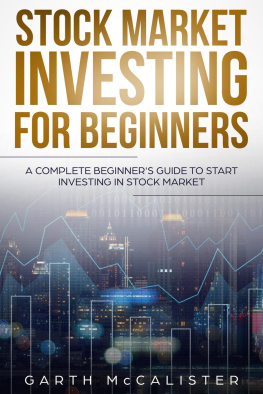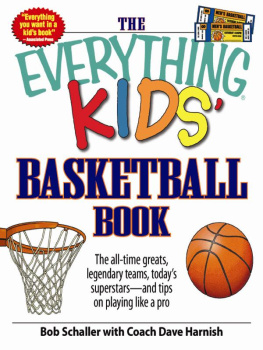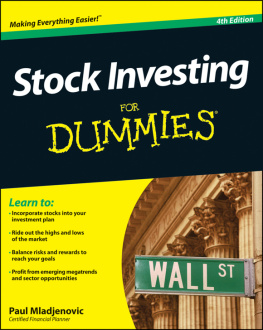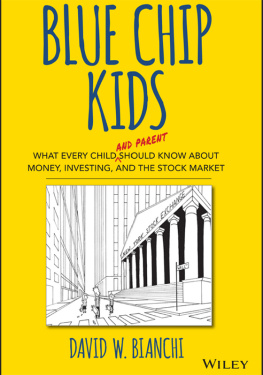Shock Exchange
How Inner-City Kids From
Brooklyn Predicted the
Great Recession and the
Pain Ahead
FOREWORD
In 2006 I started a youth mentorship program called the New York Shock Exchange (Shock Exchange) as a vehicle to share my passion for investing and basketball with my 11-year-old son and other boys his age. I figured that using basketball as a carrot would be a cool way for kids to learn about the stock market and the economy. Besides, just coaching basketball would not have been much fun for me. Somehow I had to make it educational as well. And after having played basketball in college and spending over a decade involved in corporate finance and mergers & acquisitions, I was just the person to teach it to them. And just as I had suspected, with their ability to spot trends before adults, inner-city kids from Brooklyn knew more about investing than I, Peter Lynch, Bill Miller, and any hedge fund manager or Wall Street analyst on the planet. We not only helped them perform due diligence on their stock picks, but documented how macroeconomic forces were affecting their picks and the market in general. In the process, we noticed how key drivers of the economy housing starts and auto sales were dismal. Along with rising oil prices caused by wars in Iraq and Afghanistan, the U.S. economy was in the midst of stagflation not seen since the early 1990s and the Nixon administration of the 70s. Since the Great Recession that the Shock Exchange foretold, financial literacy has been championed by the Wall Street community.
The Shock Exchanges observations on the Great Recession and the steps needed to address it have been repeated by politicians, economists, Wall Street analysts, and even the president. However, they conveniently forgot to cite the source of their information. But its not over. The next recession will be more painful than the last. I will take you on a journey of how we came to know this, the progenitors of the financial crisis, and the pain ahead.
FARMVILLE, VIRGINIA - HISTORY
I was born in Farmville, Virginia in 1967 on what my Aunt Anna describes as one of the coldest February days ever in the state of Virginia. My great grandmother, Ola Layne Allen, and Mr. Allen had to rush my mother to the hospital in Mr. Allens 1962 Dodge pickup truck you know, the old one with the stick shift on the steering wheel. Legend has it that since it was so cold, everybody knew it was going to be a boy. It would only be surpassed by the frigid February day I would get married there 28 years later. Farmville, located within Prince Edward County, is about 60 miles southwest of Richmond, the states capital. For Civil War buffs, many of the stops of Lees final retreat and the operations of General Grants successful campaigns against the confederacy occurred in Prince Edward. Lee eventually surrendered in neighboring Appomattox County. Blanche K. Bruce, the first black man elected to the U.S. Senate (1875 1881), grew up about five minutes from my house. Prince Edward is not known for much else than being your typical, small, college town. Both Longwood University and Hampden-Sydney College (H-SC or the College) are located there.
Longwood was founded in 1839 as Farmville Female Seminary Association, the third oldest public university in the state behind the College of William & Mary and the University of Virginia. Built on a reputation as a teachers college, it became a university in 2002 and has grown to over 4,000 students. Its two most famous alumni are Jerome Kersey (Portland Trailblazers) and Michael Tucker (Kansas City Royals, Atlanta Braves). Kersey enrolled there as a 63, 175-pound 18-year-old and left a 67, 225-pound grown man. His battles with Charles Oakley of Division II powerhouse, Virginia Union, are still a part of Farmville lore. Oftentimes the two had to be separated during heated exchanges. Whenever Longwood played a home game during Kerseys tenure, the entire town literally shut down. My friends and I would recap the exploits of Kersey and other Longwood greats like Joe Remar and Ron Orr. We would recant how if Oakley had tried to step to Kersey, we would have rushed the court and jumped him yeah right. Ron Orr used to attend some of our high school games; during my sophomore year he even asked me to come down to Longwood to play pick-up with him and the rest of the guys, but I never took him up on it. I was a bit flattered but I really did not think Ron Orr seriously wanted to play with little ol me. In hindsight I think I actually went to play with them once. Kersey had just graduated and was working out to prepare for camp with Portland. Dude grabbed a rebound on the far end of the court and took the ball coast-to-coast for a dunk, running over anybody who got in his way. I had never seen anybody that big move that fast before. After my self-preservation skills kicked in, I acted like I had to go to the mens room and hauled my behind home.
Founded in 1775, Hampden-Sydney is the 10th oldest college in the country, and along with Morehouse and Wabash, one of three traditional all mens institutions. It was founded by former Princeton graduates who wanted to build a liberal arts institution in Central Virginia. Patrick Henry and James Madison were members of the Colleges first group of trustees. I grew up less than a mile from the College and my brother Mark and I attended the Log Cabin School there, a pre-school taught by Ms. Frances Scott who also sang on the choir at Mercy Seat Baptist Church where we attended. Every year the college boys would have an Easter egg hunt for the kids at our Sunday school, something we looked forward to. Hampden-Sydney was somewhat of a Division III football powerhouse back then. We were not allowed to ride our bikes in the street during home games because the College boys would get a little out of control. We would sit on my grandfathers porch and watch them fly up and down the road after the games. That would be our entertainment for the weekend. Farmville pretty much caters to the college students given that they drive so much of the towns economy. Having Longwood and Hampden-Sydney in the county was something we took for granted because they were always there. In todays upside-down economy, college towns are generally the only ones still thriving. The anchors that they provide may come at a cost, just as Longwoods growth, both outward and upward, has caused some angst amongst the townspeople. Whether Hampden-Sydney will add to that angst remains to be seen.
Farmville was made famous amongst African Americans by W.E.B. Du Bois in 1898 when he wrote The Negroes of Farmville: A Social Study. Du Bois aim was to study the economic condition of the American Negro. Under the direction of the U.S. Commissioner of Labor, The Farmville Negro was the first of a series of small, well-defined studies of Negroes in the U.S. and predates Du Bois more famous study, The Philadelphia Negro which was published in 1899. It is no wonder that Du Bois focus was on Farmville, because Prince Edward County was a happening place for blacks at that time. In 1790 the countys population was 8,100 and about half was black. By 1890, the population had grown to almost 15,000 and approximately 68% was black.
Population of Prince Edward County

Source: The Negroes of Farmville
There was a community of blacks in Prince Edward who had been free decades prior to 1865, when Lincoln officially freed the slaves. Prince Edward was near the economic center of Virginias biggest industry tobacco. In Du Bois words, it was the black belt of the state, the region where the majority of its inhabitants were of Negro blood. Trading and merchandising took place in the town of Farmville, located in the northern-most section of the county. According to Du Bois, Farmville was the trading center for six counties; tobacco and an assortment of agricultural products were marketed there. On Saturday, the regular market day, the town swelled to twice its normal size due to the influx of people mostly Negroes who came into town to trade and do business.











